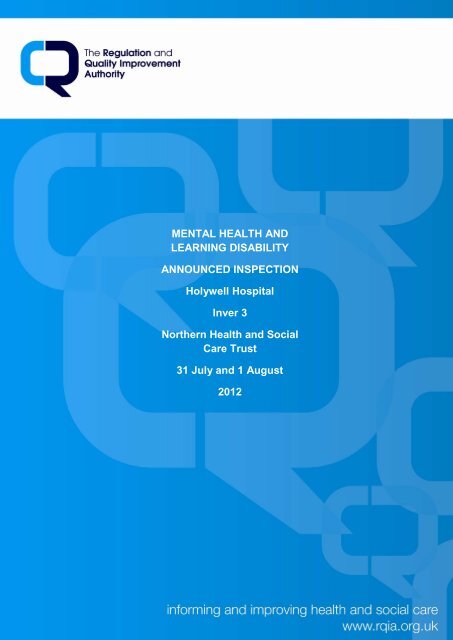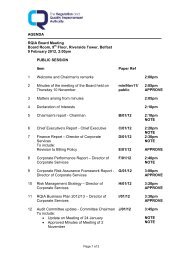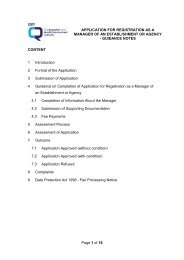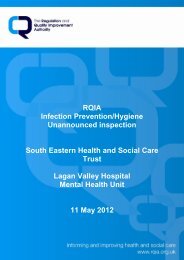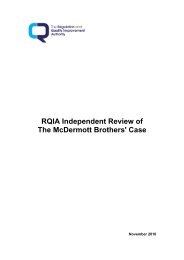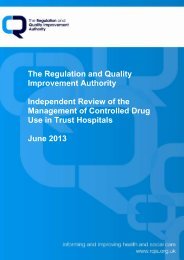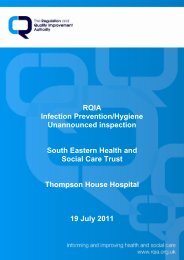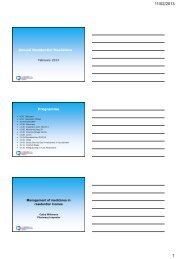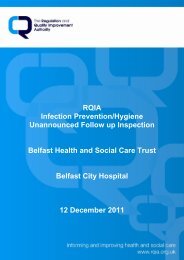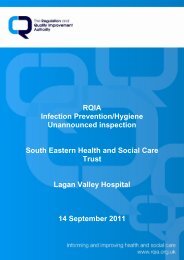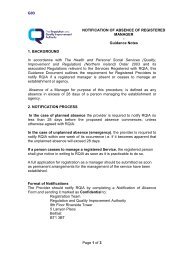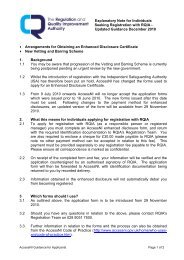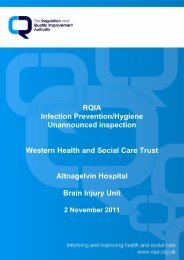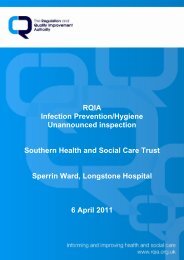Inver 3, Holywell Hospital - 31 July and 1 August 2012
Inver 3, Holywell Hospital - 31 July and 1 August 2012
Inver 3, Holywell Hospital - 31 July and 1 August 2012
You also want an ePaper? Increase the reach of your titles
YUMPU automatically turns print PDFs into web optimized ePapers that Google loves.
MENTAL HEALTH AND<br />
LEARNING DISABILITY<br />
ANNOUNCED INSPECTION<br />
<strong>Holywell</strong> <strong>Hospital</strong><br />
<strong>Inver</strong> 3<br />
Northern Health <strong>and</strong> Social<br />
Care Trust<br />
<strong>31</strong> <strong>July</strong> <strong>and</strong> 1 <strong>August</strong><br />
<strong>2012</strong><br />
1
Table of Contents<br />
1.0 Introduction ............................................................................................ 3<br />
2.0 Ward Profile ........................................................................................... 4<br />
3.0 Inspection Summary .............................................................................. 6<br />
4.0 Stakeholder Engagement ....................................................................... 9<br />
5.0 Additional Concerns Noted by Inspectors ............................................ 11<br />
6.0 RQIA Compliance Scale Guidance ...................................................... 12<br />
7.0 Summary of Compliance – RQIA Assessment ..................................... 13<br />
Appendix 1 – Quality Improvement Plan ........................................................ 16
1.0 Introduction<br />
The Regulation <strong>and</strong> Quality Improvement Authority (RQIA) is the independent<br />
body responsible for regulating <strong>and</strong> inspecting the quality <strong>and</strong> availability of<br />
Northern Irel<strong>and</strong>’s health <strong>and</strong> social care services. RQIA was established<br />
under the Health <strong>and</strong> Personal Social Services (Quality, Improvement <strong>and</strong><br />
Regulation) (Northern Irel<strong>and</strong>) Order 2003, to drive improvements for<br />
everyone using health <strong>and</strong> social care services.<br />
On 24 October 2011 RQIA informed the Northern Health <strong>and</strong> Social Care<br />
Trust of the inspection date <strong>and</strong> forwarded the associated inspection<br />
documentation. RQIA adopted the approach of self-assessment, which<br />
allowed the ward the opportunity to demonstrate its ability to deliver a service<br />
against best practice indicators. This included the assessment of the trust’s<br />
performance against an RQIA compliance scale, as outlined in Section 6.<br />
The inspection process included an analysis of the ward’s self-assessment,<br />
other associated information, discussions with ward staff, patients <strong>and</strong> a<br />
visiting professional. A range of multidisciplinary records, policies <strong>and</strong><br />
procedures were also examined as part of the inspection.<br />
An overall summary of the ward’s performance against the human rights<br />
theme of protection is in Section 3 <strong>and</strong> full details of the inspection findings<br />
are outlined in Appendix 2.<br />
3
2.0 Ward Profile<br />
Trust<br />
Name of hospital/facility<br />
Northern Health <strong>and</strong> Social Care<br />
Trust<br />
<strong>Holywell</strong> <strong>Hospital</strong><br />
Address<br />
60 Steeple Road<br />
Antrim<br />
Telephone number 02894413361<br />
Person in charge on day of inspection<br />
Mr R Luke<br />
Nature of service - MH/LD<br />
Long stay Mental Health<br />
Name of ward/s <strong>and</strong> category of care <strong>Inver</strong> 3<br />
Number of patients <strong>and</strong> occupancy<br />
level on days of inspection<br />
10<br />
Number of detained patients on days<br />
of inspection<br />
Date of last inspection<br />
Name of Inspector<br />
2<br />
Patient Experience Review - <strong>July</strong><br />
2011<br />
Carolyn Maxwell<br />
4
The ward is situated off the main corridor in <strong>Holywell</strong> <strong>Hospital</strong>, it is locked <strong>and</strong><br />
can be accessed by ringing a bell at the entrance.<br />
The ward has recently been refurbished <strong>and</strong> contains a mixture of double<br />
rooms <strong>and</strong> four bedded dormitory accommodation. There are several patient<br />
sitting areas including an activity room, a quiet room <strong>and</strong> seating along the<br />
main ward area. A patient’s snack bar area with a vending machine <strong>and</strong> tea<br />
making facilities is a recent addition to the ward accommodation. The toilets,<br />
bathroom, shower are situated off the bedroom area, with one set of toilets<br />
<strong>and</strong> the assisted bathroom accessed via the main corridor. The ward has a<br />
spacious dining room which is shared with patients from <strong>Inver</strong> 1. Patients can<br />
also access an enclosed l<strong>and</strong>scaped garden. Seating is provided <strong>and</strong> shelter<br />
for smokers is afforded on the ver<strong>and</strong>a of a neighbouring ward.<br />
The ward has input from support services daily <strong>and</strong> meals which are delivered<br />
to the ward from the hospital kitchen are heated in the ward’s kitchen,<br />
adjoining the dining room.<br />
The ward currently has a locum psychiatrist with the new consultant due to<br />
commence in September. Multidisciplinary meetings are held fortnightly.<br />
Patients also have access to occupational therapy <strong>and</strong> social work services<br />
on the ward.<br />
5
3.0 Inspection Summary<br />
An announced inspection of <strong>Inver</strong> 3 <strong>Holywell</strong> <strong>Hospital</strong> was undertaken on <strong>31</strong><br />
<strong>July</strong> <strong>2012</strong> from 9.30am – 5pm <strong>and</strong> 1 <strong>August</strong> <strong>2012</strong> from 9am – 1pm. The<br />
inspectors were Carolyn Maxwell <strong>and</strong> Margaret Cullen. The purpose of this<br />
inspection was to assess the ward’s arrangements <strong>and</strong> procedures for<br />
safeguarding vulnerable adults.<br />
The following is a summary of the inspection findings of the arrangements for<br />
safeguarding vulnerable adults on this ward.<br />
There were 10 patients on the ward at the time of the inspection, two of whom<br />
were detained under the Mental Health (NI) Order, 1986. The average age of<br />
the patients at time of inspection was 69 years. Two patients had been in the<br />
hospital for over 50 years, with the average stay in <strong>Inver</strong> 3 being 10 years.<br />
Although previously designated as continuing care the ward has recently<br />
achieved several discharges to community facilities. Community resettlement<br />
remains an aspiration for most of the patients. Two patients have no regular<br />
visitors.<br />
Patients were observed moving freely around the ward <strong>and</strong> availing of access<br />
to the dining room, seating areas, the quiet room, activity room <strong>and</strong> their<br />
bedrooms. Patients could access a snack bar for refreshments <strong>and</strong> snacks at<br />
any time. One patient used a walking aid to assist mobility another patient<br />
chooses not leave the ward on any occasions. Four patients have diabetes.<br />
One has Parkinson’s disease <strong>and</strong> one is being assessed for dementia. One<br />
patient was subject to restrictions due to potential MRSA. There was evidence<br />
of allied health professional’s involvement with patients where indicated.<br />
The ward maintains a range of policies, procedures <strong>and</strong> guidance documents<br />
in relation to the safeguarding of vulnerable adults <strong>and</strong> children. Staff were<br />
aware of safeguarding arrangements <strong>and</strong> a wide range of policies to support a<br />
safe <strong>and</strong> healthy workplace.<br />
A number of staff have undertaken training in safeguarding <strong>and</strong> there had<br />
been referrals made by ward staff with regard to vulnerable adults concerns.<br />
A recommendation was made for all staff to attend training.<br />
<strong>Inver</strong> 3 ward’s vision statement was on display on the ward along with<br />
information about complaints, hospital services, health promotion literature,<br />
advocacy, activities <strong>and</strong> the ward routine.<br />
6
Several patients were experiencing restrictions on the ward at the time of the<br />
inspection due to the locked environment. A care plan was in place which<br />
referenced this restriction although it was not detailed or personalised<br />
sufficiently. There was evidence of physical interventions being used to escort<br />
a patient back to the ward <strong>and</strong> restrictions on spending money. A specific<br />
recommendation was made with regard to one patient.<br />
The wards procedures for safeguarding patient’s monies were examined. This<br />
was complicated by a lack of clarity regarding existing competency<br />
assessments. Patients were paying for communal toiletries <strong>and</strong> tuck.<br />
Receipts, whilst provided to account for money, were not itemised. A<br />
recommendation was made to change this practice <strong>and</strong> for review of all<br />
patients capacity to h<strong>and</strong>le their own money.<br />
A patient complained about the quality of food offered. The inspector<br />
observed the lunch being served on day one of the inspection <strong>and</strong> noted that<br />
patients were given the opportunity to supplement from their chosen menu<br />
choice <strong>and</strong> food appeared appetising <strong>and</strong> was plentiful. There was also fresh<br />
fruit available in the snack bar.<br />
The ward’s incident records reflected a number of incidents in which staff<br />
were subject to physical <strong>and</strong> verbal aggression by one particular patient.<br />
Inspectors also noted incidents in which staff were reported to have used<br />
physical interventions to restrain patients. This was not documented fully in<br />
records.<br />
Staff training records were examined <strong>and</strong> reflected overdue updates in<br />
training in the use of physical interventions, manual h<strong>and</strong>ling <strong>and</strong> fire safety.<br />
Nursing staff were receiving supervision <strong>and</strong> some had undertaken an annual<br />
appraisal. All staff confirmed they had had an induction process. The<br />
corporate induction did not specify vulnerable adult policy. Recommendations<br />
were made in relation to these issues.<br />
Staff are referred to<br />
HSC/MHDP – MHU 1/10 deprivation of liberty safeguards (DOLS) - Interim<br />
guidance issued by the Department Health, Social Services <strong>and</strong> Public Safety<br />
(DHSSPS)<br />
7
In relation to the use of restrictive practices <strong>and</strong> other issues identified in<br />
respect of one patient, requested to be informed of the following<br />
recommendations were made:<br />
• assessment of patient's capacity (in relation to specific issues<br />
particularly the decision to excessively consume sugary products in<br />
light of the impact this has on diabetes <strong>and</strong> the decision not to<br />
purchase clothing)<br />
• consideration of the patient's legal status <strong>and</strong> use of force, restraint to<br />
implement care, treatment plan<br />
• provision of independent advocacy to safeguard the patient's rights <strong>and</strong><br />
to provide support<br />
• provision of specialist input in relation to patient's apparent autism,<br />
visual impairment, <strong>and</strong> need for psychological input.<br />
• document any best interests discussions involving members of the<br />
multi-disciplinary team <strong>and</strong> where possible the patients representatives<br />
or advocate.<br />
• outcome of best interests discussions, decisions made with clear<br />
outline of actions to be taken <strong>and</strong> schedule for review of these<br />
• consideration of necessity <strong>and</strong> proportionality of each restriction<br />
• consideration of the patient's human rights in relation to restrictions <strong>and</strong><br />
in particular Article 5 <strong>and</strong> Article 8 rights<br />
Inspectors would like to thank the patients, staff, relatives <strong>and</strong> visiting<br />
professionals for their cooperation throughout the inspection process.<br />
8
4.0 Stakeholder Engagement<br />
Questionnaires were issued to staff, patients, relatives, carers <strong>and</strong> visiting<br />
professionals in advance of the inspection. The responses from the<br />
questionnaires were used to inform the inspection process.<br />
Questionnaires issued to Number issued<br />
Number<br />
returned<br />
Patients 10 5<br />
Carers/Relatives 10 1<br />
Visiting Professional 5 0<br />
Staff 10 5<br />
During the inspection the inspector has the opportunity to meet with staff,<br />
patients, relatives, carers, visiting professionals or advocates. Below are the<br />
details of the number of discussions held during the inspection.<br />
Additional discussions during inspection<br />
Number<br />
Patients 2<br />
Carers/Relatives 0<br />
Visiting Professionals 1<br />
Staff 4<br />
Advocates 0<br />
The following information is a summary of feedback received from those who<br />
returned a questionnaire or met with an inspector during the inspection.<br />
Patients:<br />
Patients had been assisted by the advocate to complete questionnaires.<br />
Generally responses indicated that patients felt the care was good.<br />
One patient indicated that they had been upset by another patient <strong>and</strong><br />
received no support from staff. Another reported that they had been upset by<br />
not being allowed to buy clothing. Patients were not aware that they had the<br />
right to access their records. None of the patients identified safeguarding<br />
issues.<br />
Carers/ Relatives:<br />
Although the inspectors did not speak with any relatives individually. One<br />
response made via questionnaire returned to RQIA stated:<br />
“My brother is well cared for by all the staff. Staff will ring me up to tell me if<br />
anything is happening”<br />
9
Visiting professionals:<br />
Inspectors met with a podiatrist who attends the ward monthly. They were<br />
aware of the safeguarding policy <strong>and</strong> considered that patients were well cared<br />
for. Treatment that required to be continued was documented in patients<br />
notes, otherwise records were maintained by the staff member.<br />
Staff:<br />
Staff who participated in the inspection were generally positive <strong>and</strong> outlined a<br />
range of training <strong>and</strong> supervision undertaken. Staff were aware of the<br />
safeguarding policy <strong>and</strong> could identify forms of abuse. They outlined<br />
safeguarding arrangements for patient’s property <strong>and</strong> monies. Staff identified<br />
that good knowledge of patients enables them to diffuse potential instances of<br />
aggression between patients. One patient in particular had been violent <strong>and</strong><br />
emotionally abusive towards nursing staff. Measures were put in place to<br />
protect staff; however there was some doubt around the effectiveness of a<br />
zero tolerance in relation to abusive behavour policy in this setting.<br />
Suggestions for improvements to the ward included; more occupational<br />
therapy provision <strong>and</strong> increased availability of ward based activities.<br />
Advocates:<br />
No advocates attended the ward during the inspection.<br />
10
5.0 Additional Concerns Noted by Inspectors<br />
Ward Environment<br />
The staff toilets were accessed through the patients’ toilet <strong>and</strong> the windows<br />
opened onto the patients’ garden area. This is unsuitable. Staff had requested<br />
that a partition be erected to provide for privacy. Inspectors were informed that<br />
plans have been agreed to relocate staff WCs to an area off the link corridor<br />
to the ward.<br />
Patient toilet had a strong odour of stale urine. The ward has recently been<br />
refurbished with new flooring <strong>and</strong> plumbing installed. This had failed to solve<br />
the problem. Inspectors were informed that the works docket had not been<br />
signed off <strong>and</strong> contractors had been asked to return to find a permanent<br />
solution to the problem. There was also evidence of a leak in the ceiling of the<br />
main assisted bathroom.<br />
There was ripped flooring at the doorway from the ward to the dining area.<br />
This is hazardous particularly given the level of mobility impairment in several<br />
of the patients.<br />
Inappropriate usage of patients’ bathroom to store wheelchairs.<br />
Four of the patients on the ward were diabetic <strong>and</strong> it was noted that the<br />
vending machine had no low sugar options that would be suitable for those<br />
patients. Staff had previously raised this issue with the suppliers.<br />
Restrictions<br />
In relation to one patient (discussed during inspection feedback) RQIA<br />
suggested a range of safeguarding provisions <strong>and</strong> requested feedback once<br />
completed.<br />
11
6.0 RQIA Compliance Scale Guidance<br />
Guidance - Compliance statements<br />
Compliance statement<br />
0 - Not applicable<br />
1 - Unlikely to become<br />
compliant<br />
2 - Not compliant<br />
3 - Moving towards<br />
compliance<br />
Definition<br />
Compliance with this criterion does<br />
not apply to this ward.<br />
Compliance will not be demonstrated<br />
by the date of the inspection.<br />
Compliance could not be<br />
demonstrated by the date of the<br />
inspection.<br />
Compliance could not be<br />
demonstrated by the date of the<br />
inspection. However, the service<br />
could demonstrate a convincing plan<br />
for full compliance by the end of the<br />
inspection year.<br />
Resulting Action in<br />
Inspection Report<br />
A reason must be clearly stated in<br />
the assessment contained within the<br />
inspection report<br />
A reason must be clearly stated in<br />
the assessment contained within the<br />
inspection report<br />
In most situations this will result in a<br />
requirement or recommendation<br />
being made within the inspection<br />
report<br />
In most situations this will result in a<br />
recommendation being made within<br />
the inspection report<br />
4 - Substantially<br />
Compliant<br />
Arrangements for compliance were<br />
demonstrated during the inspection.<br />
However, appropriate systems for<br />
regular monitoring, review <strong>and</strong><br />
revision are not yet in place.<br />
In most situations this will result in a<br />
recommendation, or in some<br />
circumstances a recommendation,<br />
being made within the Inspection<br />
Report<br />
5 - Compliant<br />
Arrangements for compliance were<br />
demonstrated during the inspection.<br />
There are appropriate systems in<br />
place for regular monitoring, review<br />
<strong>and</strong> any necessary revisions to be<br />
undertaken.<br />
In most situations this will result in<br />
an area of good practice being<br />
identified <strong>and</strong> being made within the<br />
inspection report.<br />
12
7.0 Summary of Compliance – RQIA Assessment<br />
No.<br />
Question<br />
Compliant<br />
Substantially<br />
Compliant<br />
Moving<br />
Towards<br />
Compliance<br />
Not Compliant<br />
Unlikely to<br />
become<br />
compliant<br />
Not Applicable<br />
1<br />
2<br />
3<br />
4<br />
5<br />
6<br />
7<br />
8<br />
9<br />
10<br />
How do you ensure that everyone<br />
involved with the ward is aware of<br />
<strong>and</strong> underst<strong>and</strong>s the safeguarding<br />
vulnerable adult policy?<br />
List the additional procedures <strong>and</strong><br />
guidelines that you use to support<br />
the safeguarding vulnerable adult<br />
policy.<br />
List the additional procedures <strong>and</strong><br />
guidelines, aimed at promoting<br />
safe <strong>and</strong> healthy working<br />
practices, which you use to<br />
support the safeguarding<br />
vulnerable adult policy.<br />
Outline how the ward is involved in<br />
the review of the Trust’s<br />
safeguarding vulnerable adult<br />
policy, the code of behaviour <strong>and</strong><br />
the other associated procedures<br />
<strong>and</strong> guidelines.<br />
Outline how new staff are<br />
appropriately inducted into the<br />
ward.<br />
Describe how staff training needs,<br />
appropriate to the post/ role, are<br />
identified.<br />
Outline the arrangements in place for:<br />
(i) the support <strong>and</strong> supervision of all<br />
staff<br />
(ii) the annual appraisal of staff <strong>and</strong><br />
the review of volunteers<br />
Describe the arrangements in place<br />
for maintaining written records of:<br />
training completed; support <strong>and</strong><br />
supervision; <strong>and</strong> annual appraisals<br />
<strong>and</strong> reviews.<br />
Describe how the ward ensures staff<br />
<strong>and</strong> volunteers comply with the<br />
Safeguarding Vulnerable Adults<br />
St<strong>and</strong>ard 4.<br />
Outline the steps the ward has taken<br />
to ensure that staff <strong>and</strong> volunteers are<br />
competent to recognise signs of<br />
abuse.<br />
<br />
<br />
<br />
<br />
<br />
<br />
<br />
<br />
<br />
<br />
13
11<br />
Describe how the ward identifies <strong>and</strong><br />
manages risks for individual patients.<br />
<br />
12<br />
Outline the mechanisms used by the<br />
ward to ensure that vulnerable adults<br />
have the right to take risks in relation<br />
to their care.<br />
<br />
13<br />
14<br />
15<br />
16<br />
17<br />
18<br />
19<br />
20<br />
21<br />
Describe how the reporting, recording<br />
<strong>and</strong> reviewing accidents, incidents<br />
<strong>and</strong> near misses informs <strong>and</strong><br />
influences ward practice <strong>and</strong> the risk<br />
assessment <strong>and</strong> management<br />
procedures.<br />
Describe how the ward promotes <strong>and</strong><br />
communicates the Trust’s ‘ethos of<br />
inclusion, transparency <strong>and</strong><br />
openness’ to vulnerable adults,<br />
carers, advocates, family members,<br />
staff <strong>and</strong> volunteers.<br />
Describe the procedures in place for<br />
carers, advocates <strong>and</strong> vulnerable<br />
adults to share concerns they may<br />
have or to make complaints about the<br />
organisation.<br />
Outline the steps the ward has taken<br />
to encourage carers, advocates <strong>and</strong><br />
vulnerable adults to raise concerns or<br />
make a complaint following an<br />
incident.<br />
Outline how the ward ensures that<br />
staff know <strong>and</strong> comply with the<br />
records management policy.<br />
Outline the mechanisms the trust has<br />
in place to inform vulnerable adults<br />
about their right to access to<br />
information held about them.<br />
Describe how the ward ensures that<br />
staff, volunteers <strong>and</strong> visitors know<br />
about <strong>and</strong> adhere to the Code of<br />
Behaviour.<br />
outline how the ward safeguards<br />
patients’ rights in relation to the use<br />
of:<br />
(i) restrictions on the ward<br />
(ii) isolation/ seclusion<br />
(iii) close observation<br />
(iv) restraint<br />
Outline the mechanisms for the<br />
h<strong>and</strong>ling of vulnerable adults’ money.<br />
<br />
<br />
<br />
<br />
<br />
<br />
<br />
<br />
<br />
22<br />
23<br />
Outline how the ward ensures the<br />
safety of patients’ property while on<br />
the ward.<br />
Describe what arrangements the ward<br />
has in place for children visiting the<br />
ward.<br />
<br />
<br />
14
24<br />
Outline the safeguarding<br />
arrangements the ward has in place<br />
for the admission of an under 18 year<br />
old.<br />
<br />
15


